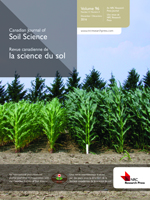Georgallas, A., Dessureault-Rompré, J., Zebarth, B. J., Burton, D. L., Drury, C. F. and Grant, C. A. 2012. Modification of the biophysical water function to predict the change in soil mineral nitrogen concentration resulting from concurrent mineralization and denitrification. Can. J. Soil Sci. 92: 695-710. Uncertainty in soil N supply is an important limitation in making crop fertilizer N recommendations. This study modified a biophysical water function developed to predict net soil N mineralization, making it possible to consider how both N mineralization and denitrification processes affect the rate of soil mineral N accumulation. Data were from a published experiment measuring changes in soil mineral N concentration in five soils of varying texture (loamy sand to clay loam) incubated for 3 mo with or without addition of red clover residue and at two levels of compaction. The biophysical water function was effective in fitting the relationship between scaled change in the rate of soil mineral N accumulation (ΔSMN) and scaled water-filled pore space (WFPSS) across soils and treatments provided that WFPSS=1 was set to the water content at which the transition from mineralization to denitrification occurs. The water content at WFPSS=1 varied with soil type, but not residue addition or compaction treatments, and was closely related to clay content. The kD parameter, which controls the denitrification term of the function, was influenced by soil type, whereas legume residue application had no significant effect on the kD parameter despite a twofold increase in net N mineralization. The modified biophysical water function holds promise for improving estimates of soil N supply because it can predict changes in ΔSMN in response to N mineralization and denitrification processes across a wide range of soil water contents.
BioOne.org will be down briefly for maintenance on 17 December 2024 between 18:00-22:00 Pacific Time US. We apologize for any inconvenience.
How to translate text using browser tools
1 August 2012
Modification of the biophysical water function to predict the change in soil mineral nitrogen concentration resulting from concurrent mineralization and denitrification
Alex Georgallas,
Jacynthe Dessureault-Rompré,
Bernie J. Zebarth,
David L. Burton,
Craig F. Drury,
Cynthia A. Grant
ACCESS THE FULL ARTICLE
It is not available for individual sale.
This article is only available to subscribers.
It is not available for individual sale.
It is not available for individual sale.

Canadian Journal of Soil Science
Vol. 92 • No. 5
August 2012
Vol. 92 • No. 5
August 2012
amendements organiques
compactage relatif
organic amendments
pores remplis d'eau
relative compaction
soil type
type de sol




